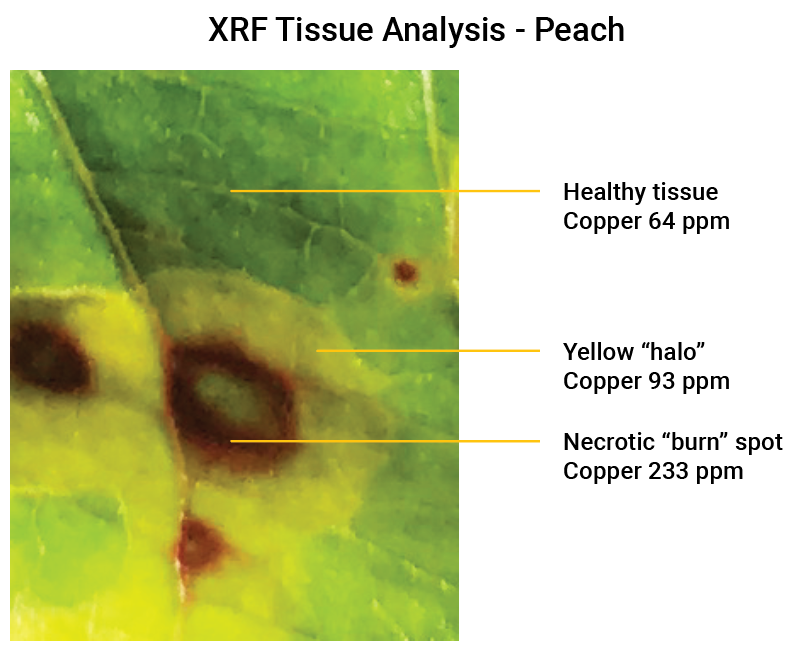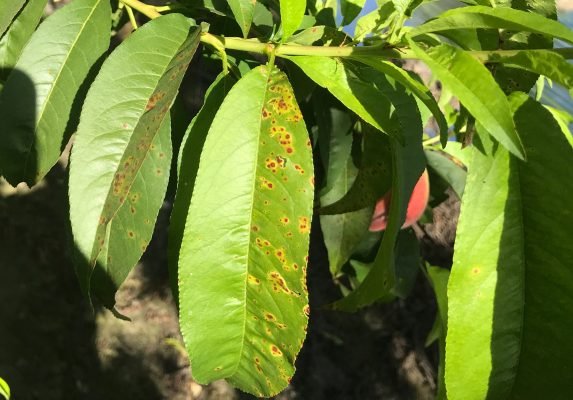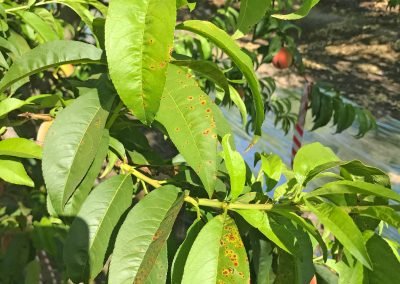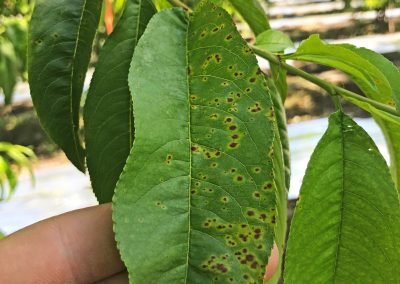
Here’s what the scene lookED like:
Symptoms:
- Small “burn” spots on leaves
- Inconsistent pattern of “burn” spots on tree and leaves
- Higher concentration of “burn” spots near ends of rows
- Symptoms did not spread after initially observed, but many of the affected leaves did fall off
Field Info:
- 6-year-old peach and nectarine trees, Fresno County, CA
- First time applying the specific copper-based foliar. Foliar sprays with copper had been used before but this was the highest rate applied to date.
- No other spray applications were done during this time.
- Spray was conducted on a sample set of trees; not all trees in block were sprayed, and only those that were sprayed showed symptoms.
Here’s what we know about spray burn and stonefruit:
- “Spray burn” is a generalization for burn-like symptoms on leaves and/or fruit that can be attributed to one of two causes. Both types of spray burn can have similar visual symptoms.
- pH burn: Lowering the pH of a spray can increase the rate at which the plant absorbs the nutrients in the spray. If the plant is not able to dissipate the high concentration of the nutrient, it can result in spray burn symptoms.
- Severe nutrient toxicity: When too much of a nutrient is applied to plant tissue, the plant cannot dissipate the nutrient and symptoms such as edge necrosis, discoloration, etc. may result (symptoms vary based on the nutrient and crop).
- The pattern of spray burn symptoms is often irregular within the plant and on the leaves/fruit, but may show up at the bottom tips/edges of leaves and fruit where the material concentrates as it drips & dries. The pattern within the field is typically irregular as well; however, near the ends of the rows it is common to see higher concentrations of the burn symptoms. This is because the plants near the ends of the rows commonly get sprayed with extra materials as spray equipment tend to slow down at row ends.
- While many kinds of stonefruit are known to be tolerant of copper, it is documented that peaches and nectarines are more susceptible to copper toxicity.
Connecting the Dots:
- Only trees that were sprayed with the foliar showed burn symptoms. This:
- Rules out insect or disease causes
- Points towards issue with spray material
- No issues were observed when material was applied at a similar rate to cherries and plums, suggesting that not all stonefruit is equally tolerant of the material.
- Online research shows that peaches and nectarines are known to be sensitive to copper phytotoxicity. [Copper Phytotoxicity in Peach and Nectarine]
- Application was recreated shortly after with same material and rate on similar crops
- Peaches and nectarines again showed burn symptoms
- Analysis of affected tissue showed excessive concentrations of copper within burn marks

Case wrap-up:
The spray burn symptoms were likely a severe nutrient toxicity reaction to the copper content of the spray material. It is unclear whether the main cause of the toxicity was due to the rate of copper applied, the pH of the material or a combination of the two.
***
Thank you Kaitlyn Garcia from Tulare Ag Products for letting us dig deeper with you on this case!










